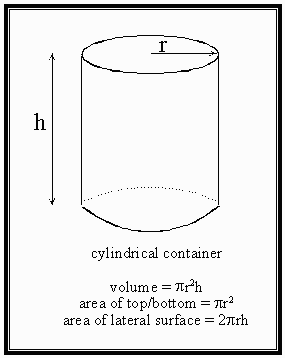Solution:
We need to find the dimensions of this container which
minimize the total cost of material. Maximization/minimization
problems of this type are all solved using the following
steps.
Step 1:
Write down a formula for the quantity that is to be maximized
or minimized: here the Cost, C, of materials, required. We need
to define r to be the radius of the circular cross section of the
container, and h to be its vertical height. Further, let k stand
for the cost per square centimeter of the material used in
fabricating the cylindrical tube. Then the material used for the
circular top and bottom of the container will cost 2k per square
centimeter. Thus,

We have two independent variables here, but one can be eliminated
using the requirement that the container hold 1.875 litres.
Equating the formula for the volume of the container to this
value gives

where we have converted the given volume to its equivalent in
cm3 to facilitate balancing of units later. Thus

in units of cm. Substituting this into our formula so far for
C gives finally,

Since k is a constant (which does not need to be known to
answer this question), we have now successfully expressed C as a
function of the single independent variable, r.
Step 2
The maximum or minimum of a function will occur either for
values of the independent variable where the first derivative
equals zero, or at the extreme possible values of the independent
variable (in this case r = 0 or r =∞ both give C =
∞ , so these options can be ignored). Thus,
differentiating,

Setting this to zero gives

(The k has cancelled out.) Taking the cube root gives to two
decimal places, r = 4.56 cm, and substituting into the formula
for h gives 28.67 cm.
Step 3
There is just one set of
dimensions that may give a minimum cost container. We need to
provide an argument, all the same, that these dimensions do give
a minimum cost. (After all, we may have improperly stated our
goal, and so this single solution could give the most expensive,
or maximum cost, container). The easiest way to argue this point
is to note that the second derivative of the cost,

is positive for all positive values of r, and so is certainly
positive for r = 4.56 cm. This confirms that we have a minimum
value of C here.
Thus, the container with the lowest cost of materials should
have a radius of 4.56 cm, and a height of 28.67 cm.
Possible Variations
- Find the dimensions of the cylindrical container with a
1.875 litre capacity which will minimize the total surface area
of the container.
- Assume that the circular top and bottom of the container
must be cut from square pieces of material measuring 2r on a
side, with the extra bits of material being considered waste.
What dimensions of the 1.875 litre capacity container would now
lead to use of least material per container?
- Typically a seam exists vertically down the cylindrical
tube, and around the edges of the circular top and bottom of
the can. Find the dimensions of the 1.875 litre capacity
cylindrical container which minimizes the total length of
seams.
- One could start out with a specified total surface area,
say 1200 cm2, and then find the dimensions of the
cylindrical container which would have the largest volume
capacity.

